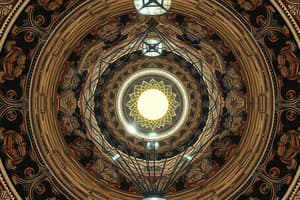Podcast
Questions and Answers
Which path will a ray parallel to the principal axis follow after reflection in a concave mirror?
Which path will a ray parallel to the principal axis follow after reflection in a concave mirror?
- Appear to diverge from the principal focus
- Pass through the principal focus (correct)
- Emerge parallel to the principal axis
- Reflect back along the same path
What happens to a ray directed towards the principal focus of a convex mirror after reflection?
What happens to a ray directed towards the principal focus of a convex mirror after reflection?
- Diverges from the principal focus (correct)
- Emerges parallel to the principal axis
- Reflects back along the same path
- Passes through the principal focus
What path will a ray passing through the centre of curvature of a concave mirror follow after reflection?
What path will a ray passing through the centre of curvature of a concave mirror follow after reflection?
- Pass through the principal focus
- Diverge from the principal focus
- Emerge parallel to the principal axis
- Reflect back along the same path (correct)
How are the incident and reflected rays oriented with respect to the principal axis in the case of oblique incidence towards the pole of a mirror?
How are the incident and reflected rays oriented with respect to the principal axis in the case of oblique incidence towards the pole of a mirror?
What is the general behavior of light rays with regard to following the laws of reflection in all cases described?
What is the general behavior of light rays with regard to following the laws of reflection in all cases described?
Which incident ray orientation results in emerging rays that are parallel to the principal axis in the case of a convex mirror?
Which incident ray orientation results in emerging rays that are parallel to the principal axis in the case of a convex mirror?
What is common among all types of reflecting surfaces?
What is common among all types of reflecting surfaces?
What is the relationship between the focal length of a spherical mirror and its radius of curvature?
What is the relationship between the focal length of a spherical mirror and its radius of curvature?
What happens to a light ray when it travels obliquely from a denser medium to a rarer medium?
What happens to a light ray when it travels obliquely from a denser medium to a rarer medium?
What is the speed of light in vacuum?
What is the speed of light in vacuum?
What is the refractive index of a transparent medium?
What is the refractive index of a transparent medium?
What is the direction of the emergent ray in a rectangular glass slab?
What is the direction of the emergent ray in a rectangular glass slab?
What is the primary condition for the laws of reflection to be applicable?
What is the primary condition for the laws of reflection to be applicable?
What is the relationship between the angle of incidence and the angle of reflection?
What is the relationship between the angle of incidence and the angle of reflection?
What is the orientation of the incident ray, the normal to the mirror, and the reflected ray?
What is the orientation of the incident ray, the normal to the mirror, and the reflected ray?
What is the shape of the surface required for the laws of reflection to be applicable?
What is the shape of the surface required for the laws of reflection to be applicable?
What is the purpose of a highly polished surface in relation to reflection?
What is the purpose of a highly polished surface in relation to reflection?
What is the relevance of the laws of reflection in understanding optical phenomena in nature?
What is the relevance of the laws of reflection in understanding optical phenomena in nature?
Flashcards are hidden until you start studying




